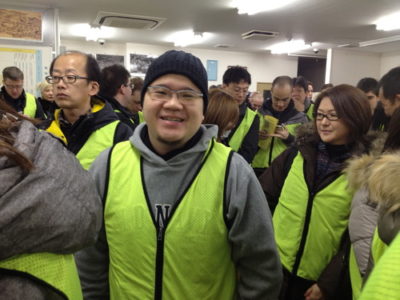
My second full day in Japan started early, 330 am (230 am Manila time), to be precise. It was such as ungodly hour that I half expected a ghost or apparition would appear in my tiny hotel room to scare me to death. Unlike most days, however, I didn’t mind waking up this early. After all, I was going to Tsukiji Market, the Temple of Sushi.
I got to the Fish Information Center to line up for the tuna auction at around 420 am. They only allow 120 tourists to watch the auction per day and to my surprise, I wasn’t even the first (or the 15th) person in line. After chilling outdoors with a Spanish couple and basically humiliating my old Spanish teacher by butchering my conversational Spanish (a donde a la biblioteca?) the 120 of us were herded into the waiting room. Here we were given bright yellow vests for safety (and also so market purveyors could look at us with disdain as ‘those evil tourists,’) plus specific instructions on how not to get killed inside the market. Repeated warnings of watching out for moving forklifts and trucks and not using flash photography were ingrained in our minds through sheer repetition (for about 40 minutes) and then we were off!
The most striking visual of the tuna auction was of course the number of blue fin tuna available for auctioning. One of the guides reported that a storm was the main reason for the “small” haul, but I could easily count a hundred tuna, averaging 200 pounds lying around already. The auction promptly started and as the auctioneer was mouthing off, it was quite a trip to see the wholesalers gesture with their fingers whether they were bidding higher or stepping away from the fight. Bidding for paintings would put me to sleep but bidding for food somehow makes a lot of sense to me. I could’ve watched the entire thing, but we were herded away so that the second batch of 60 people could come in and have their turn.
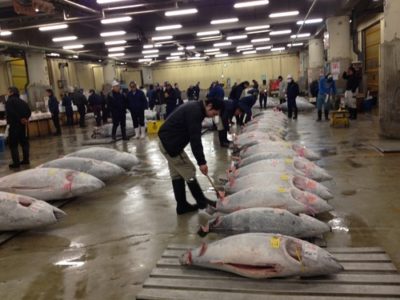
As some of the members of the group began to leave the market, I knew they were making a big mistake. I wandered off to the side of the market looking for more gratification. I wanted a breakfast of the freshest sushi in the world.
As per the golden rule, I lined up to eat at the place with the longest line (not of tourists, but of locals) which in this case was one and the same. Sushi Dai, acknowledged by both tourists and locals as the best place to get sushi, already had a line at 6 am. I lined up and waited. And waited. My total wait time ended up being 2 hours (which is ridiculous with the temp at 7-8 degrees C at the time) but I made good use of it. I got to make friends there at the line and we were like the United NAtions. by the time I got into Sushi Dai, Filipino me had conversed with 2 Japananese, 2 Americans, 2 Canadians, 1 Argentinian, 1 Korean and 1 Cantonese. Sushi brings world peace, Ms. Universe contestants!
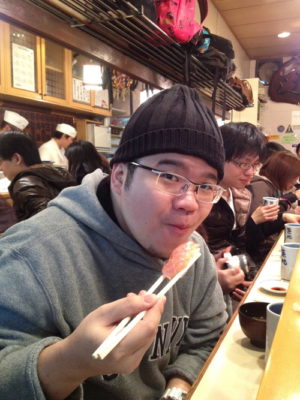
Sushi Dai is a super small sushi bar where only 12 people can sit at any given time. As per Japanese custom, sushi is served one by one at the bar and you can enjoy a conversation with the sushi maker like the way you would a bar tender. My latest Argentinian and Korean friends, who were Japanese language teachers in their home countries, got to practice their Japanese and translated for me. I think even the sushi maker was weirded out. Here he was, speaking Japanese to a caucasian while he was translating to me, an obvious Asian guy. Anyway on to the meal!
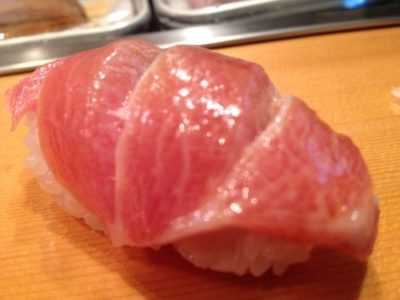
We ordered Omakase of course, as it’s both a compliment to the chef and an assurance you get the best meal. It started with some tea and miso soup, both excellent and much appreciated after waiting in the cold. Next was O-toro sushi, fatty belly of the tuna. Fatty, melt-in-your-mouth goodness. Rich and velvety, freaking awesome. After that a white fish the chef couldn’t identify in English, but my bet was silver jack and it was very nice. It had a bit more richness than a normal white fish sushi. Red Snapper sushi was next and I was surprised to see the skin served as well. The skin wasn’t chewy and dissolved as easily as the meat! Very surprising for sure.
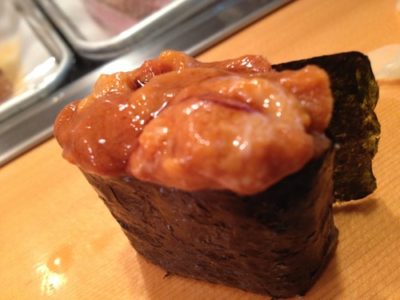
Uni or Sea Urchin was next and it was quite an experience. The uni was so rich and tasted so much of the ocean that you could get lost and drown in it. Sardine sushi was served with some chopped ginger and salt and I loved it. I wonder if I can get that in Manila as I would love to try it again. Giant clam sushi was fun to as it “moved” a bit as it was served to us. It was an illusion of course, but the great texture and flavor was not. A hint of sweetness and an awesome texture from the raw shellfish brought me great joy as you can imagine.
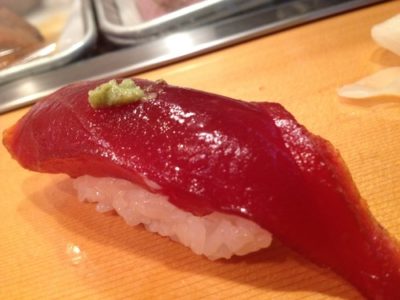
Katsuo, more known to us as dried Bonito, was served in sushi form and it was great too. Very similar to tuna sushi, only less fatty. A quartet of rolls with chopped tuna and ebiko greeted us next and while they were great seemed like an intermission of a great show. Amaebi or sweet shrimp was next and the light handed treatment of the shrimp made the texture and the sweetness of the shrimp shine through. Another great example of how in cooking, less is more most of the time. Japanese Mackerel served with leeks was so good I’m considering ordering Mackerel here in Manila. Grilled Sea Eel sushi was placed in front of us and it was yet another rich, satisfying sushi bite. Pesky bones were none existent and so was any fishy smell. Our last piece was guest’s choice and I was tempted to try the Abalone or the Scallop, but the evilness of the O-Toro was like a Siren’s call tricking me to my doom.
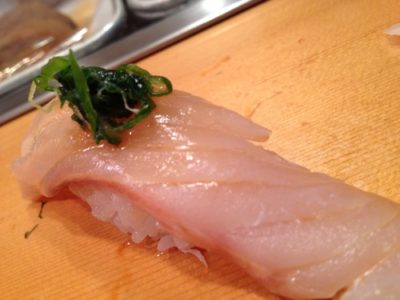
As we paid (3900 yen) which isn’t bad for quite an experience, and left, I realized why hundreds of thousands of people brave the early wake up call and the long lines to have their sushi breakfast. If breakfast is the most important meal of the day, it makes so much sense to have it where sushi is at its freshest and greatest.